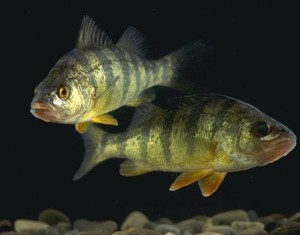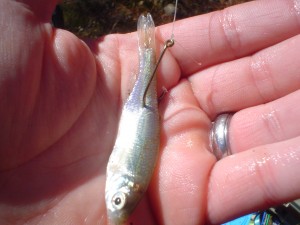Do you feel as if you have graduated from catching Bluegills or Sunfish? Then a good species to target next would be the Yellow Perch. Perch are great to fish for if you are a novice angler as they are relatively easy to catch. They generally offer fast fishing action in many conditions. You need to have fast reflexes however as perch are known to nibble an unsuspecting fisherman’s bait clean off his/her hook. Perch can grow larger than the average Bluegill and provide a decent fight once on the line. They are considered one of the best tasting freshwater fish. The below information is full of Perch fishing tips that that will help to increase your chances of catching more perch.
Perch Fishing Facts
Perch are generally small not growing any larger than 5lbs. On average Perch that are caught are no larger than 1lb. They have large lidless eyes that can spot a spinner or other flashy object well in clear water. Choosing bait that will vibrate or wiggle in the water would be a good choice while fishing for Perch as they are equipped with a lateral line system. This system helps the Perch to hone in on a struggling fish in the water. Numerous other species also have this system including the Perch’s larger cousin the Walleye.
Perch have sharp dorsal spines which help to protect them from other predators like, Largemouth Bass, Pike and Walleye.
One great thing about perch fishing is that they are a school fish, so if you catch one perch odds are many more will be near by. They do move very often so be sure to keep them interested if you are starting to catch them. In some states it is legal to chum for Perch and this generally produces good results as it will bring schools closer to your boat or where you are located on shore.
They have small mouths so be sure to use very small tackle. I try to use the smallest hooks I have available while fishing for Perch. Ensure that you bait the hook properly as they will rob your bait if they can easily nibble off the end of your worm.
There are numerous Aquaculture farms for Perch throughout the United States where they are harvested and sold as they are considered one of the best tasting freshwater fishes.
Like the Bluegill and Catfish, Perch are know to be able to live in poor water quality conditions. In low oxygen and high nitrate conditions they survive much better than other species.
How to Catch Perch?
The bait that I use most frequently when fishing for perch are worms, either trout worms or night-crawlers. I will use a float or bobber with about 2 to 3 feet of line extended from it. If they are on the bottom I will just replace the float with a weight. Depending on the bottom structure I will either have a three way rig or just have my hook at the bottom of the line. A three way rig consists of having the weight at the bottom of the line and then a dropper loop placed a few feet from the bottom of the line. An eagle claw hook can then be added to the dropper loop.
I have also had luck catching Perch with small shiners. If I know that I will be fishing for perch I will buy 6 to 12 of the smallest shiners the bait shop has to offer.
Trying to locate Perch can sometimes lend itself to be challenging and a good depth finder is helpful to find drop off or underwater vegetation where a school of Perch may be hiding.
Perch are found in schools so one tip is to attach three of four hooks to your line below your bobber or weight. This can result in catching multiple Perch at the same time. A similar rig can be used for other school fish like Bluegill.
Where to Catch Perch?
Some additional perch fishing tips relate to where to find them. Perch have a very widespread demographic. They can be caught from most lakes, ponds and rivers throughout the united states and other species of perch can be caught in other countries. The most common species of Perch caught in America is the Yellow Perch.
In regards to where in the lake they can be caught, Perch are often found in the same areas where you will find bass or sunfish. The larger perch will be found in deeper waters and in waters that are more open, whereas the smaller perch will be found in shallower waters and in weedy areas where they can easily hide from predators. I often will use a three way rig with about 3 feet of line from the bottom when I am fishing for Perch. A good fish finder is useful when trying to determine the depth that they are located.
In the summer a majority of Perch can be found in deeper waters. In the spring and fall they can be found in somewhat shallower locations.
Perch are common all throughout the Northeast, Mid West, West Coast as well as many southern states. Their eggs are thought to have a sticky coating which aids in the Perch’s fertilized eggs to travel long distances on floating debris or water birds.
Based on some tagging studies Perch generally do not migrate any farther than 30 miles, which means that they cover much more distance over the course of a year than the average Largemouth Bass.
Tackle Recommendations for Perch Fishing
Some additional Perch fishing tips include what tackle to bring to the lake or pond. I have found that not much tackle is required to have a successful day Perch fishing. I never fish for Perch using any more than a 10 lb weighted line as they rarely grow over five lbs. In regards to the fishing rod, I have a light action Zebco rod that I use, which has more than enough strength to handle a decent size Perch. In my tackle box I bring some spinner bait, Rooster tail, small plugs, flies and medium sized bait hooks. Three way swivels are also handy when fishing with live bait. A few teardrop sinkers as well as some bobbers are helpful once I determine where the Perch are and what they are feeding on.
Perch feed on organisms that are fairly low on the food chain, such organisms are small insects, zooplanktin (which are microscopic organisms), small fish, frogs and other small amphibians. They are not a cannibalistic species like the Pike or Walleye.
Proper Perch Handling
Perch like numerous other freshwater fishes have a protective slime around their bodies. Be sure to wet your hands before holding a perch as this helps to preserve the protective coating around the fish. This slime helps to defend the fish from bacteria and infection from getting under their scales. When the Perch fishing starts getting fast I switch to barb less hooks to ensure that the fish goes through less trauma while out of the water. A Perch can be revived in much the same manner as many other fish. Simple place the Perch in the water and rock it forwards and backwards to allow oxygen to flow over their gills. This will help to revive them quicker and have a better chance of survival. Also be careful of their sharp dorsal spines as they can easily stab an unsuspecting angler.
When is the Best Time to Catch Perch?
Perch can be caught in just about any season. Some anglers believe that Perch fishing is best in the later half of the summer, but Ice fisherman also catch perch fairly regularly as well. Some fairly large Perch have been caught while ice fishing in the Mid West and North East regions of America. If you do plan on ice fishing for perch, first check with your local DEM office to ensure that the ice is safe to walk on and second make sure that you make your fish hole big enough. You would hate to loose a big Perch because you did not make your landing hole big enough. I do not believe that their is any real bad time to fish for perch
Late evenings or early mornings generally produce good results while Perch fishing in the Summer and Spring seasons. Perch have fairly good vision so the first light of the predawn hours generate good results when using spinner bait or spoons.
Perch spawn in the spring when the water temperatures are around 43 to 49 degrees Fahrenheit. Their eggs have a sticky coating with allows them be carried long distances. At these times the larger Perch can be caught closer to the shorelines
Using Perch as Bait
Many larger predator fish feed on Perch fry, such species include Large-mouth Bass, Pike, Walleye and Catfish. They can be rigged in the same manner as any other bait fish, but I recommend placing an average size fish hook that exposes the point of the hook through the upper tail region of the Perch. This ensures that the Perch can swim freely and prolongs its life while on the line. Walleye are know to prey on Perch regularly during certain times of the year so they make an ideal bait if you catch a small to average size Perch. Also catfish will feed on pieces of Perch that have sunk to the bottom. Finding a shady area underneath a bridge or overhanging area with a hook baited with Perch can generate a decent size Catfish.
A Personal Perch Fishing Story
In the summer of 2010 a few friends and I fished a local lake in Rhode Island for Bass, Pike or whatever was biting that day. It was a very warm sunny day, so we knew we had a few factors working again us already, as cloudy or overcast days are preferable. We took our small Jon boat to some local popular spots on Echo Lake with no luck. A few hours went by when I saw a very small patch of Lilly pads in the middle of the lake. So I was able to talk my fellow anglers into trying a new fishing spot. They agreed and we set anchor and first tried the surface with shiners with no luck. I then tried the bottom by attaching a small split-shot to my line. Within seconds I had my first hit of the day. I reeled it in hoping for a large bass, but It was a fairly nice sized Perch around 2lbs in weight. Immediately we all switched to the same rig and began landing Perch fairly consistently for the next few hours. We were all amazed at how fast we were landing them and were surprised that the fishing action lasted so long. We all had Perch for dinner that night and began to make that a new favorite fishing location. Sometimes finding the fish makes all the deference. On a follow up trip I brought my depth finder and realized their was a large hump with much vegetation on that spot.
Perch Cooking Recommendations
Perch are generally not that big, however they are a very tasty fish. The do not have a “fishy” taste at all. Often times a simple recipe is to simply to gut and scale the perch after removing its head or tail. Wash it thoroughly in warm water, sprinkle lemon on both sides and place a healthy portion of Butter or Margarine in its gut cavity. Wrap it with tin foil and bake it for 15 to 30 minutes at 350 degrees. The tin foil is optional, but helps to keep the butter close to the fish meat which makes it softer and juicier.


